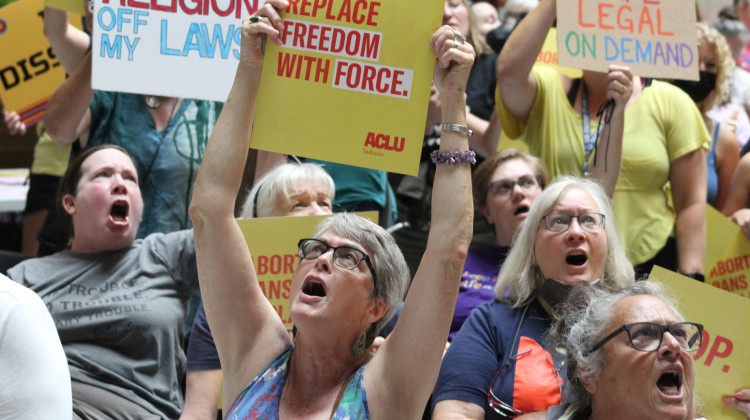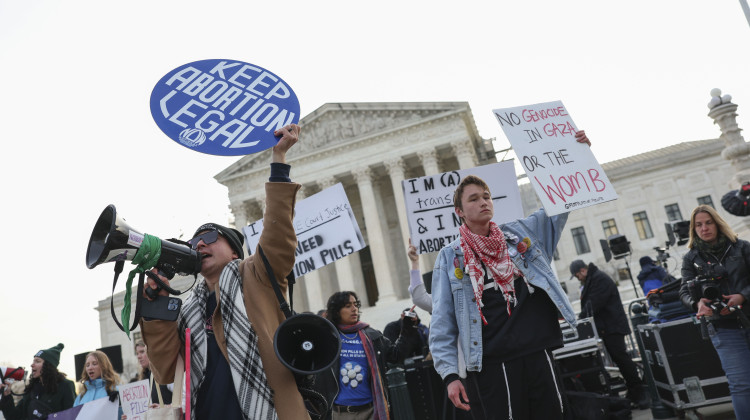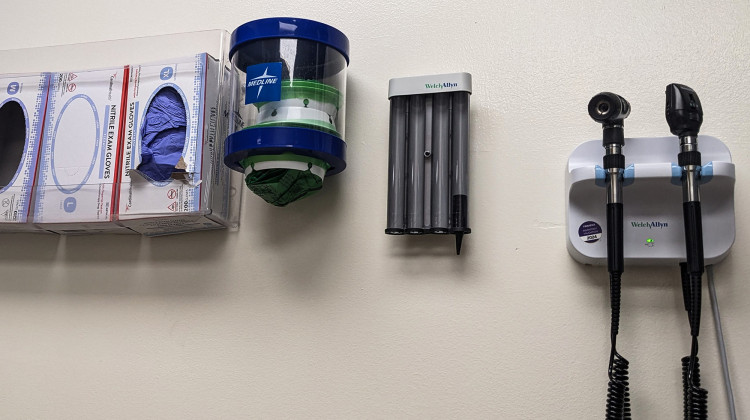
While abortion remains legal in states like Ohio, Illinois and Michigan, many residents who want an abortion cant get one in-state. Abortion clinics are flooded with requests, including from people in places where abortion is banned.
Ben Thorp / WFYIBy Morgan Watkins
Indiana is on track to almost entirely ban abortion starting August 1 following a state Supreme Court decision at the end of June. This will curtail abortion care for Indiana residents and will have ripple effects that people in other states will feel soon.
“Obviously, the Indiana ruling … is not only devastating for Indiana, but for surrounding states – particularly folks living in the South who have made Indiana, of all places, a destination to receive abortion care,” said Alison Dreith of the Midwest Access Coalition, which helps people afford the cost of traveling to get an abortion in Midwestern states.
Where patients go for abortion care depends on various factors, including what’s closest geographically and when appointments are available at a clinic. Now that Indiana’s Supreme Court cleared the way for a near-total abortion ban, options for care are getting slimmer and the strain on abortion havens will ratchet up.
Almost an abortion haven
While most abortions in Indiana have been provided to in-state residents, state data shows that a fifth of the people who got an abortion there last year came from a different state.
A total of 950 people crossed state lines into Indiana from Kentucky, where abortion is banned unless there’s a life-threatening risk to the pregnant patient.
Savannah Trebuna who oversees the Kentucky Health Justice Network’s Abortion Support Fundsaid people in the Louisville area typically go to Indiana, although that won’t be an option for much longer. Meanwhile, people in Western Kentucky often go to Illinois, and Virginia is a big access point for people in Eastern Kentucky.
Then, there is Ohio. A total of 611 women came from the Buckeye state, where abortion remains legal until about 22 weeks of pregnancy, but only because a six-week abortion ban is temporarily blocked in court. It’s possible Ohio could end up seeing that ban reinstated, just like Indiana’s.
In the first quarter of 2023, the number of abortions performed in Indiana dropped sharply compared to the same period last year. Still, 340 people traveled from Kentucky for an abortion between January and March of this year, representing nearly 90% of out-of-staters.
More states in the Midwest and the South are taking steps to try to restrict abortion access for their residents.
Indiana’s abortion ban “will increase the stress on the abortion safety net,” Dreith said.
While abortion remains legal in states like Ohio, Illinois and Michigan, many residents who want an abortion can’t get one in-state. Abortion clinics are flooded with requests, including from people in places where abortion is banned.
This means it can take weeks before some people can find an appointment at a clinic.
The Midwest Access Coalition helped clients not just from Kentucky and Ohio, but also from Georgia, Tennessee, Texas and even Illinois, get abortions in Indiana this year, Dreith said.
A game of Tetris
For women seeking abortion care, time is of the essence. Different states have different rules for how far along a pregnancy can be before abortion is prohibited and many have required waiting periods between when a patient meets with a health care provider to discuss terminating their pregnancy and when they actually can get an abortion.
And the longer they wait for an abortion, the more expensive the procedure can become.
Tamarra Wieder, the Kentucky state director of Planned Parenthood Alliance Advocates, said making sure everyone gets an abortion in a timely manner is like playing Tetris.
“We don't want anybody to go without care. But you know, there are only so many appointments and only so many providers,” Wieder said.
When Indiana’s ban takes effect, Kentucky residents will lose “their second home for abortion care,” she said.
Even in Indiana, while abortion has been legal, some people sought care out of state. Jessica Marchbank of the Hoosier Abortion Fund, said about 35% of the Indiana residents her organization helped afford abortions over the past year or so went out of state for care.
There are fewer abortion clinics open in Indiana now than there were two years ago, Marchbank said. Right now there are only six abortion providers in the state, and they’ve been sought out by more out-of-state patients as access across the South and the Midwest became increasingly limited.
“It's just gotten more and more difficult for [Indiana residents] to get to an appointment,” said Marchbank, who is the state programs director for the nonprofit All-Options, which manages the fund.
She said the strain on the remaining clinics’ staff has been difficult, especially with the looming likelihood – and, as of June 30, the certainty – that Indiana’s ban would get reinstated by the Indiana Supreme Court.
“A crucial access point to abortion care is about to be cut off,” she said.
Bans building off each other
Abortion is more restricted across the Midwest now than it was before the Supreme Court overturned its 1973 Roe v. Wade ruling last summer. But it’s still more available there than it is in the South, where most of the states with near-total abortion bans are located.
When its own ban is reinstated in August, Indiana will join a growing list of 14 other states that have almost entirely outlawed abortion.
Wieder said that Planned Parenthood will keep helping people in Kentucky and Indiana figure out where they can get a legal abortion.
“I don't want anybody to lose hope,” she said. “Planned Parenthood is going to make sure that you get the appointments that you deserve and should have had in your home state.”
But with options for care slimming, this could mean people having to travel further and jump through extra hoops, she said.
Clinics in states where abortion remains legal will try to absorb the increased demand for care after Indiana’s ban takes effect. But that could increase wait times and staff burnout.
“We’re not just looking at Kentucky and Indiana relying on access states, but also most of the Deep South,” said Trebuna of the Kentucky Health Justice Network’s Abortion Support Fund. “Any ban on abortion has ripple effects, and it impacts everyone.”
This story comes from a partnership between Louisville Public Media and Side Effects Public Media, a health reporting collaboration based at WFYI. Side Effects is a collaboration of NPR stations across the Midwest and surrounding areas, including KBIA, Iowa Public Radio, Louisville Public Media, KCUR and Ideastream Public Media
9(MDAyMzk1MzA4MDE2MjY3OTY1MjM5ZDJjYQ000))
 DONATE
DONATE








 View More Programs
View More Programs

 Support WFYI. We can't do it without you.
Support WFYI. We can't do it without you.